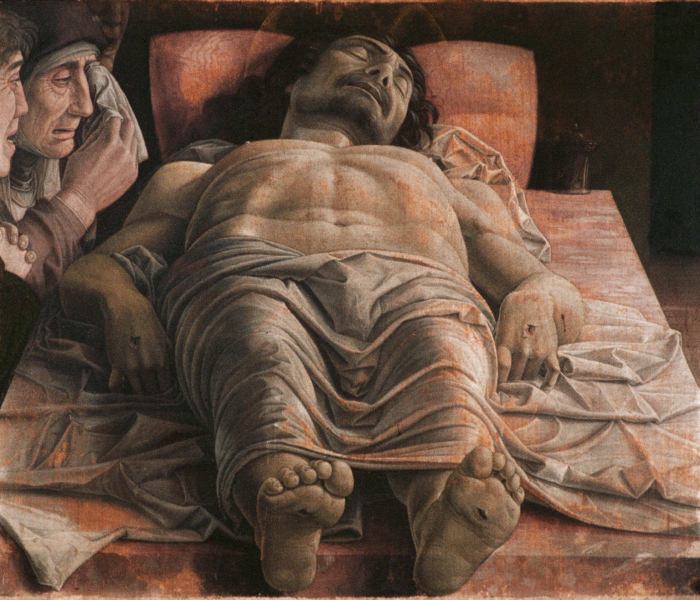Saturday afternoon1. Of the grey and empty room, you glimpse a corner of the stone floor that leads to an opening to the dark.
A boy and two women are holding a wake over a corpse. It is lying on a white-streaked red marble table, it has been washed and prepared to be buried. On its right there is an unguentarium, with the ointments for the anointment of the body. The boy joins his hands and looks at the dead man that was a friend of his, by his side an old woman cries and wipes her tears with a handkerchief. She is his mother. Of the other woman, young and beautiful, you can only see the mouth, wide open in a desperate cry. The corpse belongs to a man, aged between thirty and forty, his hair and beard dark. Long. He has suffered stab injuries on hands and feet, you can discern a cut on his chest, the inflicted deathblow. His head is bowed to one side, his expression is serene, almost relaxed.
The Lamentation over the dead Christ was painted by Andrea Mantegna for his own tomb in the Basilica of Sant’Andrea in Mantua2.
In the same years, Francesco Bonsignori tells us the beginning of this story3 from his own perspective, as daring as the one we have just described. This time the mother occupies the centre of the stage, with her joined hands towards her child, who is abandoned to a deep sleep, fearfully similar to death. The little child is half naked and his genitals are exposed, revealed to confirm his most human side. He is not lying in a cradle or a manger but on a white-streaked red marble slab, exactly like the stone of anointing, a relic kept in Jerusalem’s Holy Sepulchre, the same funeral stone painted by Mantegna, red with white streaks created by the tears of the Holy Virgin, according to the legend.
The two paintings tell the first chapter and the epilogue of a story that began and ended for love, in which the baby, instead of instilling the mystic magic of nativity or an innocent tranquillity in his mother’s arms, anticipates the ending, a flash-forward that closes a circle, a testimony – the only one – of a temporary death and the beginning of eternal life.
1. This scene takes place on the Holy Saturday, within the period called “Quarant’ore” (forty hours). In this lapse of time, Jesus Christ would be simultaneously dead as a man and alive as God.
2. After his death, on the 13th of September 1506, the painting was reported to be still in his atelier. It was subsequently bought by the Gonzaga family together with other works by Mantegna and the family kept it until the first half of the Seventeenth century. Now it is kept at the Brera Art Gallery.
3. Francesco Bonsignori, Madonna with Child, 1483, Castelvecchio Museum, Verona.

